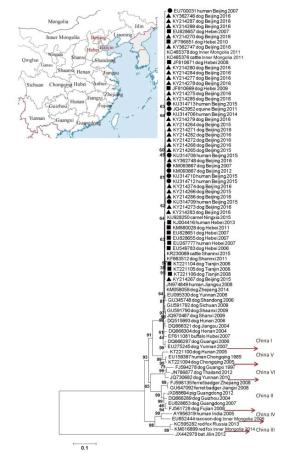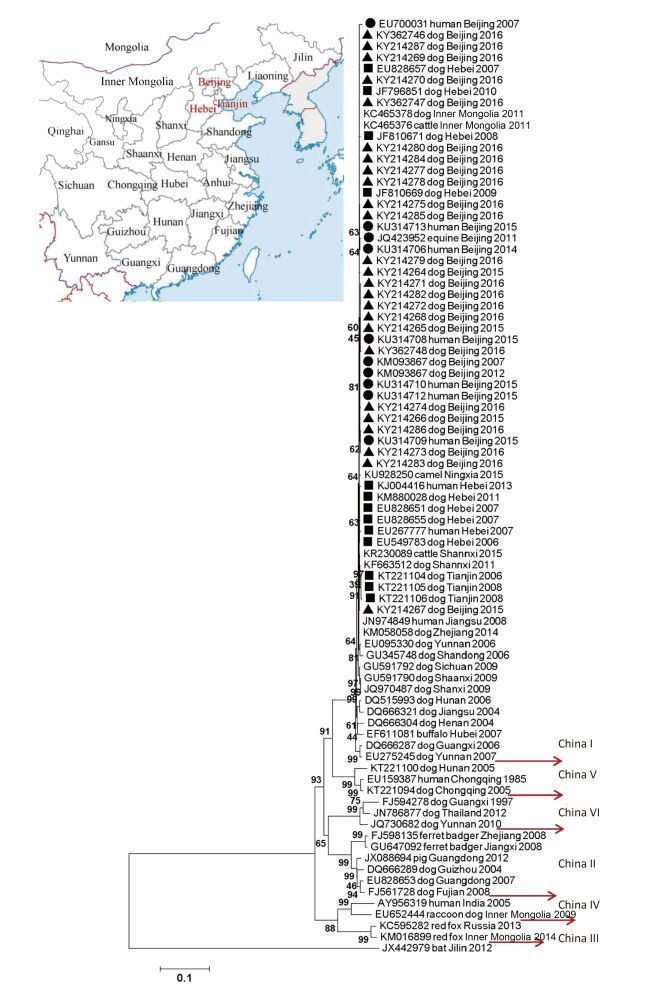-
Rabies remains a continuous threat to public health in Beijing. In this study, a total of 224 brain tissues were collected from suspected infected stray dogs within Beijing between January 2015 and December 2016. Among them, total of 67 samples were diagnosed positive for rabies. In the phylogenetic analysis, rabies in Beijing is currently a relatively independent public health issue originating from local rabid dogs apart from the imported cases from elsewhere in the country. Because vaccination of unregistered dogs against rabies is still neglected in Beijing and other regions of China, national and local authorities should play central roles in all related aspects, such as development of policies, engagement of stakeholders for public and professional education, entire vaccination process, and animal management.
Rabies virus is mainly transmitted by bites of infected dogs resulting in approximately 99% of human rabies cases worldwide, mainly in the developing countries in Asia and Africa[1]. In China, rabies remains a continuous threat to public health, because vaccination of reservoir animals, such as dogs (particularly stray dogs), against rabies is still neglected in most regions in this country[2]. The ineffective control and prevention of dog rabies has caused three large epidemic waves of human rabies since 1949[2]. The increased use of human rabies vaccines (currently 15 million doses annually) has reduced the reported human rabies deaths from the latest epidemic peak of 3, 301 cases in 2007 to 561 in 2016[2]. In Beijing, the capital of China, no human rabies case has been reported during 1994-2004. However, since the emergence of one case in 2005, the numbers of reported human deaths caused by rabies have remained largely unchanged (from 1 in 2006 to peaks of 13, 12, and 2 in 2012, 2015, and 2016, respectively; the data from Chinese Center for Disease Control and Prevention). Unregistered dogs, particularly stray dogs, in the suburbs in Beijing provide a rabies reservoir because of the low vaccine-immunization coverage ( < 20%)[3].
To analyze the genetic diversity and phylogenetic characterizaiton of dog transmitted rabies viruses in Beijing, a total of 224 brain tissues (59 in 2015 and 165 in 2016) were collected from suspected infected stray dogs with history of biting human and clinical signs of rabies within Beijing between January 2015 and December 2016. The samples were sent to our laboratory (Laboratory of Epidemiology, Military Veterinary Research Institute) by the Beijing Municipal Center for Animal Disease Control and Prevention. A total of 67 samples (22 in 2015 and 45 in 2016) were diagnosed positive for rabies using direct immunofluorescence test[2]. Viral nucleoprotein (N) genes were amplified by the reverse transcription polymerase chain reaction and sequenced in both directions[2], of which 42 duplicate N sequences were excluded. The rest (25 N sequences) were submitted to the GenBank, with accession numbers shown in the Figure 1 (▲). A phylogenetic tree was constructed using the maximum likelihood method in MEGA 7.0.14, as described previously[2]. Other reference sequences of the major lineages within China were retrieved from GenBank, with accession numbers shown in the Figure 1.

Figure 1. Maximum-likelihood phylogenetic tree based on the complete N gene sequences of rabies lyssaviruses isolated in China, rooted with Irkut lyssavirus (JX442979) isolated in China. ▲: Rabies viruses isolated in Beijing in this study. ●: Rabies viruses isolated in Beijing in previous reports. ■: Rabies viruses isolated in Hebei and Tianjin in previous reports.
In this study, all detected viruses were classified as China I, which is currently the main lineage originating from dogs nationwide (Figure 1). Most viruses were similar to the dog-associated strains collected from contiguous regions in northern China, including Hebei, Tianjin, and Inner Mongolia (Figure 1). We found < 3% diverse between these isolate sequences in this study. However, the viruses isolated from dogs are more similar to those from humans and animals in Beijing (Figure 1), which strong nucleotide identity (99.3%) was shown. These viruses appear to have developed genetic diversity as independent enzootics, although Beijing is surrounded geographically by Hebei province with Tianjin municipality in the southeast where human rabies is also a continuous and serious public health issue[4-5]. Therefore, rabies in Beijing is currently a relatively independent public health issue originating from local rabid dogs apart from the imported cases from elsewhere in the country.
Continuous rabies surveillance in dogs is being conducted by local officers of the Center for Animal Disease Control and Prevention only in several major cities in China, such as Beijing and Shenzhen. The dog population in urban Beijing has increased dramatically since 2000, with over one million dogs registered and with rabies immunization coverage of approximately 80% because of the regular vaccination by approximately 435 authorized pet hospitals[3, 6-7]. However, the precise number (approximately 300, 000-500, 000 in Beijing) and immunization status of unregistered dogs are unknown not only in Beijing but also in other regions in the country[2-4]. In China, dog registration is a police responsibility, but dog owners are required to bear the cost. Urban management officers are responsible for stray dog control, although this responsibility is limited because of inadequate government-run facilities to shelter stray dogs. Veterinarians of the Ministry of Agriculture are responsible to administer vaccines but only to registered dogs. Additionally, in the absence of any national laws or regulations, or even adequate education, many dog owners are unaware of their obligations and responsibilities. Consequently, some dogs are abandoned and/or left to roam. For certain technical and official reasons, no oral vaccine for stray dogs is available in China[2]. Organizing the vaccination of unregistered dogs is therefore the key problem facing national rabies prevention[8]. Legislation and regulations regarding rabies prevention should be improved.
Rabies is a vaccine-preventable zoonotic disease that has been controlled and even eliminated in many countries[1]. The US claimed dog rabies free in 2007 despite the disease burden in wild animals[1]. Associated successes have been predominantly attributed to mass vaccination strategies[9]. China and the US have a similar geographic size, and are the top 2 largest economies. During human rabies elimination in China, Beijing should play a leading role in achieving the World Health Organization (WHO) goal of eliminating dog-mediated rabies by 2030[9]. A blueprint for human rabies elimination has been clearly outlined by the Blueprint for Canine Rabies Prevention and Control developed by global rabies experts[10]. National and local authorities should play central roles in all related aspects, such as development of policies, engagement of stakeholders for public and professional education, entire vaccination process, and animal management.
doi: 10.3967/bes2017.069
-
注释:
-
Figure 1. Maximum-likelihood phylogenetic tree based on the complete N gene sequences of rabies lyssaviruses isolated in China, rooted with Irkut lyssavirus (JX442979) isolated in China. ▲: Rabies viruses isolated in Beijing in this study. ●: Rabies viruses isolated in Beijing in previous reports. ■: Rabies viruses isolated in Hebei and Tianjin in previous reports.
-
[1] Hampson K, Coudeville L, Lembo T, et al. Estimating the global burden of endemic canine rabies. PLOS Negl Trop Dis, 2015; 9, e0003786. doi: 10.1371/journal.pntd.0003786 [2] Liu Y, Zhang HP, Zhang SF, et al. Rabies outbreaks and vaccination in domestic camels and cattle in Northwest China. PLOS Negl Trop Dis, 2016; 10, e0004890. doi: 10.1371/journal.pntd.0004890 [3] Wang C, Wang Y, Du X, et al. Rabies immunization status of dogs, Beijing, China. Emerg Infect Dis, 2011; 17, 1129-30. doi: 10.3201/eid1706.101590 [4] Tao XY, Tang Q, Rayner S, et al. Molecular phylodynamic analysis indicates lineage displacement occurred in Chinese rabies epidemics between 1949 to 2010. PLOS Negl Trop Dis, 2013; 7, e2294. doi: 10.1371/journal.pntd.0002294 [5] Montgomery JP, Zhang Y, Wells EV, et al. Human rabies in Tianjin, China. J Public Health, 2012; 34, 505-11. doi: 10.1093/pubmed/fds041 [6] Animal disease control and prevention in Beijing. Beijing Municipal Bureau of Agriculture. http://www.bjny.gov.cn/nyj/232120/232655/232659/482538/index.html[2013-12-11] [7] Yin W, Dong J, Tu C, et al. Challenges and needs for China to eliminate rabies. Infect Dis Poverty, 2013; 2, 23. doi: 10.1186/2049-9957-2-23 [8] Chen Y, Tian J, Chen JL. Challenges to eliminate rabies virus infection in China by 2020. Lancet Infect Dis, 2017; 17, 135-6. doi: 10.1016/S1473-3099(16)30589-8 [9] No authors and institutes listed. Aiming for elimination of dog-mediated human rabies cases by 2030. Vet Rec, 2016; 178, 86-7. doi: 10.1136/vr.i51 [10] Lembo T, Partners for Rabies Prevention. The blueprint for rabies prevention and control:a novel operational toolkit for rabies elimination. PLOS Negl Trop Dis, 2012; 6, e1388 doi: 10.1371/journal.pntd.0001388 -




 下载:
下载:




 Quick Links
Quick Links